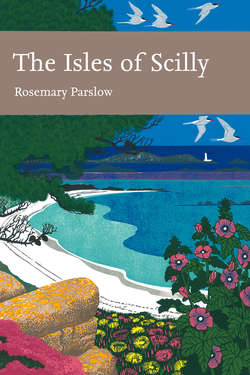Читать книгу The Isles of Scilly - Rosemary Parslow - Страница 25
EARLY HISTORY – THE SUBMERGENCE
ОглавлениеTwenty thousand years ago most of Britain was under the last glaciation, extending as far south as the Wash and south Wales. At this time sea level would have been as much as 120m below Ordnance Datum. Then the climate ameliorated and by 13,000 BP the Devensian ice had almost disappeared (Selwood et al., 1998).
Four thousand years ago, before the sea inundated the land, Scilly would have had a very different landscape, with low hills and sand dunes surrounding a shallow plain (Fig. 11). Based on the present-day undersea contour lines, there would at that time have been three main islands: the principal one would have included the present-day St Mary’s, Tresco, Bryher and St Martin’s, the Norrard Rocks, the Eastern Isles and the St Helen’s group; Annet and St Agnes would have made up a smaller second island group; and the Western Rocks would have been the third. Later the islands became parted as the sea rose still further. The long isolation of St Agnes from St Mary’s and the rest of Scilly may possibly explain the differences in the flora – for example why the least adder’s-tongue fern Ophioglossum lusitanicum is restricted to St Agnes.
Most accounts of the submergence of the Isles of Scilly are based on the model proposed by Thomas in Exploration of a Drowned Landscape (1985). Thomas suggests that sea level rose rapidly and reached to within a few metres of present-day levels by 6000 BP, although final submergence of the island of Scilly to
FIG 11. A map showing how the main islands may have appeared prior to the submergence. (After Thomas, 1985)
create the present archipelago may not have been effected until post-Roman times. Archaeological and historical evidence show that although sea was rising on a unitary island about 2000 BC, ‘submergence began in earnest during Norman times and was effectively completed by the early Tudor period’ (Thomas, 1985; Selwood et al., 1998). However, Thomas recognised that although his model assumes a gradual process of submergence, there is an alternative picture with a series of dramatic events such as tidal surges. According to Ratcliffe and Straker (1997), submergence may have been even more gradual than Thomas proposes. The most controversial aspect of Thomas’s model is his suggestion that separation of the islands did not occur until early Tudor times. Although the exact details of when and how the marine inundation took place are unclear, remains of huts, walls and graves on areas now covered by the sea are irrefutable evidence that it took place.
